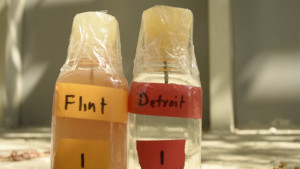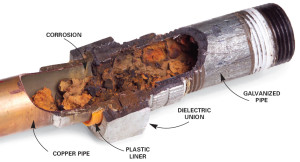Flint Water
After 30 years in the water industry, I thought I should give my take on the Flint, Michigan water crisis. There is a misconception that the water from the Flint River the state emergency manager switched to is poisonous. Not true. Properly treated, the Flint River water is fine, and would meet all safe drinking water standards.
The problem is that the water was not properly treated. As it comes from the river, the water is corrosive and attacks metals in the distribution system pipes. To be safe, it must be treated to make it less corrosive. There are chemical additives (phosphates) that coat the pipes and prevent lead and copper from leaching into the water. Here in Denver, lime or soda ash are added to raise the pH of the water, making it less corrosive. In addition, over time a thin film of calcium carbonate forms on the inside of the pipes, effectively sequestering the toxic metals. The phosphate chemicals do the same thing.
How can you tell if your water is safe? The corrosive water also attacks the rust that forms in an old system, such as in Denver or Flint. If your water is red, it has rust, but also lead and copper. The lead and copper come from the pipes, not the river. The rust won’t hurt you, just stain your fixtures. The lead comes from lead solder (now outlawed) used to join copper pipes and from lead pipes once used to bring water from the main into the house. The lead service lines are slowly going away, but many houses have galvanized steel pipes into the house. These are safe, but that steel pipe won’t bend to attach to the tap on the main, which is high on the pipe to keep sediment out of the service line. The solution, a flexible lead loop bending from the tap to the service line.
In Denver some older houses have lead service lines, but the lead loops are more common. My entire neighborhood in South Denver with houses dating from the Victorian era to the 1940’s has lead loops. Most of them are replaced when the old galvanized pipes rust out and there is a leak. Our house has a copper service line now. Several houses on the block have had their old service lines replaced since we have lived there. Look where the water line comes into your house. If it is copper, you are OK. Flint has the same situation.
Aggressive water leaches lead and copper out of the pipes and renders the water toxic. Lead is the most dangerous, as it is a neurotoxin especially dangerous for developing fetuses and young children. Copper is also toxic, but copper pipes are more resistant to corrosion than lead.
If you have red water in your house, it is possibly dangerous and needs to be tested. The Flint water is not just red, it’s red mud. Before the Safe Drinking Water Act, many small water systems had aggressive water. As a kid, I watched red water flow into our bathtub, especially in the spring, when the water was mostly runoff. Maybe that is why I am nuts, as well as the rest of us from Fruita.
How did this happen in Flint? Flint has a treatment plant, but was using water from Detroit which has good corrosion control. Flint has plans to switch from the Flint River to Lake Huron as their water source. Lake Huron water is higher quality than river water, making it less expensive to treat. Detroit water is from Lake Huron. The Michigan emergency manager for Flint ordered the switch to river water to save money.
Flint is broke. The demise of much of the U.S. Auto industry hit Flint hard, a General Motors town. The result, white flight, leaving a population mostly poor and black. The city couldn’t pay its bills and the state took over with a team appointed by the Governor. Here is the root of the problem. The federal Safe Drinking Water Act establishes standards for drinking water. The law gives the states the option to administer the law, usually by the Health Department or the Environmental Quality Department.
So, the State government is running the Flint government and water treatment process and is also charged with insuring the water is safe, a clear conflict of interest. A wild card? Racism. Those poor black people did not have much political clout and were essentially ignored and belittled when they complained about their water. It took a brave pediatrician seeing high lead levels in her patients to finally get action.
Four governmental entities are involved. The Flint city government was rendered superfluous when the state assumed control. The federal EPA was passing the buck to the Michigan Environmental Quality Department and not doing due diligence in making sure the department was doing its job (the EPA administrator lost his job). The state environmental quality regulators knew there was a problem, but were influenced by the Governor’s emergency management. The result, a perfect bureaucratic storm, with the people of Flint as victims.
The cost? A public health crisis that will cost millions to fix. It takes a long time for the calcium carbonate or phosphate coating to form in the pipes. In the meantime the water is unsafe. The people of Flint will have to be provided with bottled water for some time. Lots of bureaucratic fingers are being pointed. There is plenty of blame to go around. Will anyone go to jail? Probably not, even though there is now a special prosecutor. If the local Flint city government had been simply subsidized by the state until it got its house in order, the whole thing could probably been avoided. Instead the emergency managers put money ahead of the public health.
Many conservatives want to reduce the size of government, and return to the nineteenth century, before there was water treatment and people died of waterborne disease. Government built a system to protect public health. If government does not have the money do do its job, the public health will suffer. Do you want safe water? Don’t move to Flint.






